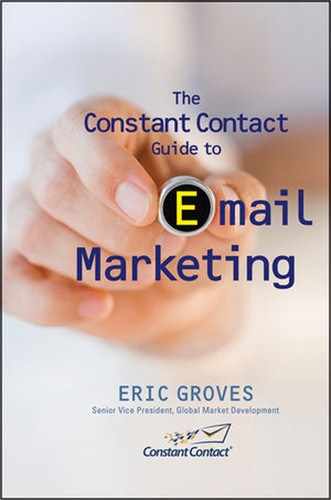Reaping the Soft Benefits of Email Marketing
In addition to the direct financial benefits of email marketing, there are a number of other financial benefits that are difficult to track. For example, if your logo appears in an email, you might not see sales from people who drove right over to your store to make a purchase, but it might make your web site seem more familiar to a visitor who has seen the email, and that might make her more comfortable making a purchase at a later date.
These kinds of benefits are known as soft benefits. I can tell you firsthand that soft benefits translate into financial impact, and I can also tell you that you shouldn’t spend any time or money trying to emulate the big money branding strategies you see from large companies in hopes of receiving soft benefits in return.
The right approach to soft benefits is to pay attention to them and let them happen while you’re pursuing measurable direct-response communications. The next sections explain many of the soft benefits you can derive at a low cost while you’re gaining from the more direct benefits of your email marketing strategy.
TOP-OF-MIND AWARENESS
Have you ever spent a lot of time with potential customers teaching them about your products or services, only to find out that they made a purchase from someone else? When you hang up the phone or the customer walks out the door of your office or leaves your web site, the opportunity to stay “top-of-mind” with your customer starts to diminish. The more time that elapses, the greater the likelihood that the customer will forget all about the services or products you offer.
It happens to everyone at one time or another because even people with the best intentions make purchase decisions based on being in close proximity to an offer at the precise time when they are ready to make a purchase. When you send professional-looking email communications, you remind your audience that you exist and you’re ready to serve them when they need you.
Top-of-mind awareness also helps you gain referrals. When one of your customers gives a referral, he or she is likely to share the first few businesses that come to mind. If you’re in front of your customers with regular email communications, you’re more likely to be at the top of the list.
Competition among hotels on Cape Cod is high due to the tourist-based, seasonal nature of the region. As the proprietor of the Crowne Pointe Historic Inn and Spa, David Sanford wanted customers to think of his hotel as a signature Provincetown destination twelve months a year (see Figure 3.3). David abandoned his traditional marketing approach in favor of email marketing, which enabled him to regularly reach out to customers in a timely, inexpensive way that captured Crowne Pointe’s elegant brand. He sends monthly updates about hotel, spa, and restaurant promotions to his list. As a result of his efforts, he has been able to greatly improve year-round attendance at special and promotional events.
There are two ways you can improve your ability to bring your customers back: customer loyalty (developed over time through a buildup of trust) and contact information (which provides you with the ability to maintain regular contact).
In the case of new customers or prospective customers, you have not yet had a chance to build up trust, so the ability to maintain contact is even more important. When it comes to customers with whom you have a lot of existing loyalty, email marketing works to “tap them on the shoulder” and say, “Do you need my services this month?” and “Do you have any friends who might?”
Figure 3.3 Crowne Pointe Inn stays top-of-mind with professional-looking campaigns.

HEIGHTENED BRAND IDENTITY
Your customers need to be able to distinguish you from the competition and feel confident in your ability to provide what they need. The more times someone sees your logo, business name, colors, and other identifying features of your business, the more confident they will feel that your business is legitimate.
If you’re a small business, you don’t need everyone to be able to draw your logo from memory, but you do need to make your business familiar to your audience. The best way to do that is by repeating the same brand elements in a consistent way.
Building an identity also increases the response rates from your other marketing efforts when you use consistent branding (see Figure 3.4).
Figure 3.4 Building an identity with email involves consistent branding across all communications.

INCREASED CUSTOMER LOYALTY
Loyal customers will bypass the competition on the way to your store, office, or web site, because they trust you more than they trust the competition. Customer loyalty can be built through your email communications when you communicate your desire to continue the relationship with your customers after making a purchase.
For example, compare a used car dealer who sells you a faulty car and disappears with a used car dealer who sells the same faulty car but sends a follow up email asking for your feedback and is willing to correct the problem when your response points to a disrepair.
Loyalty results in more frequent purchases, higher purchases per transaction, and other benefits that aren’t necessarily tied to the number or cost of communications you send.
There are three major takeaway points when it comes to understanding the economics of email marketing. First, email marketing is not a standalone marketing strategy. It works in concert with all your other marketing efforts. Second, when done right, email marketing will make all your other marketing investments more effective. Finally, email marketing is most effective in helping you stay relevant and connected with the people that already know what you have to offer.
..................Content has been hidden....................
You can't read the all page of ebook, please click here login for view all page.
